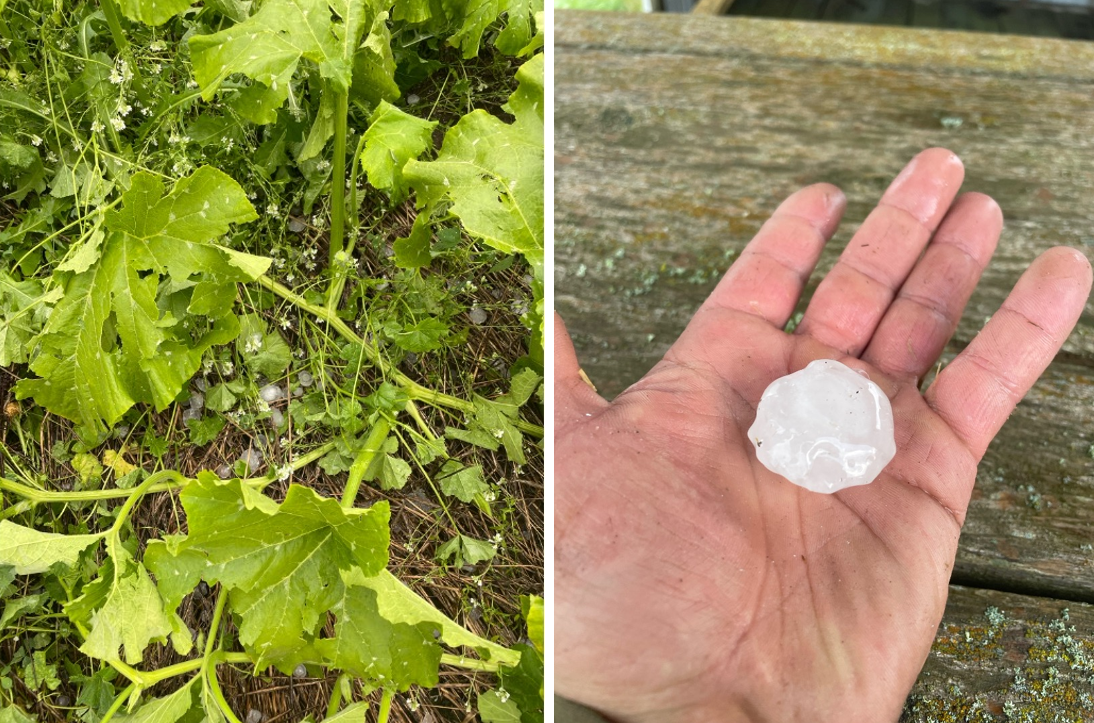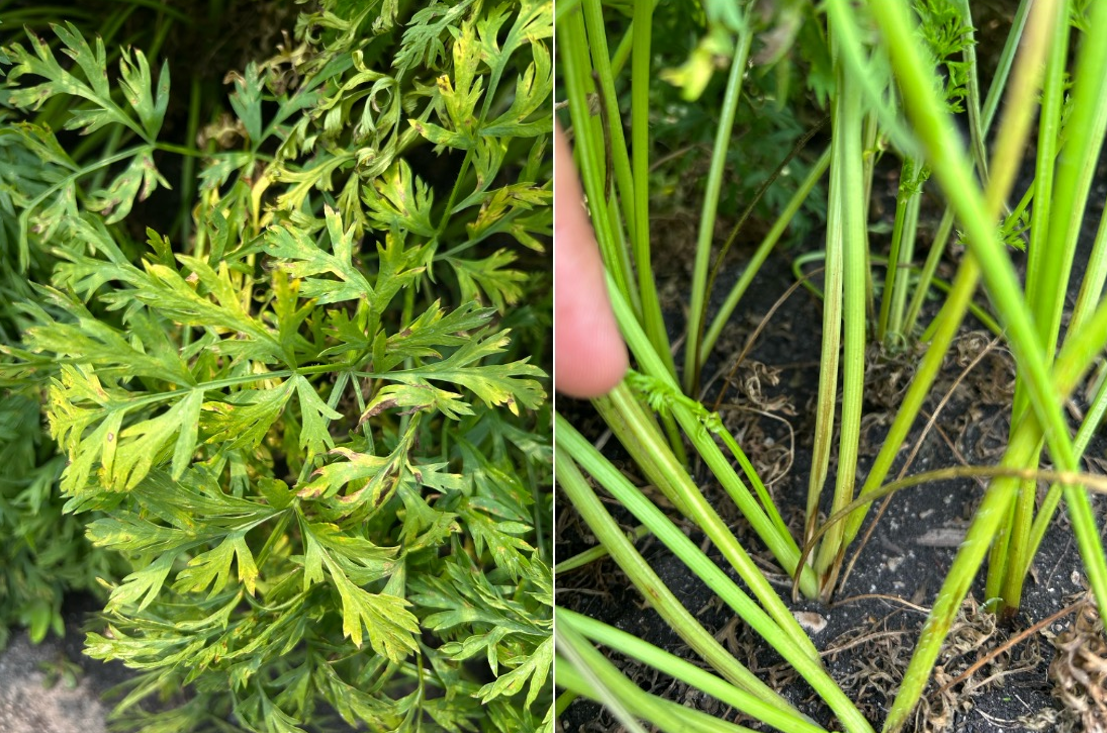Michigan vegetable crop report – August 13, 2025
Vegetable harvest continues as fall crops begin to ripen.

Weather
Many areas of Michigan are almost a week ahead in growing degree days, and a large swath from southwest Michigan to the Bay area has been through a prolonged dry period. Evapotranspiration rates were very high and irrigation has become increasingly important. More smoky haze is expected Thursday, Aug. 14. Scattered showers and thunderstorms are potential Saturday.
This week’s forecast calls for:
- Isolated showers possible early Wednesday in the southeast. Otherwise, it will become sunny and cooler. Mostly fair and dry Thursday and Friday. Warmer with scattered showers and thunderstorms possible in the northwest overnight Friday, spreading to the southeast into Lower Michigan by Saturday evening and Sunday. Cooler with scattered showers possible Monday and Tuesday of next week.
- High temperatures from the upper 60s north to mid-80s south Wednesday, 70s north to low 80s south Thursday and Friday and mid-80s south to low 90s by Saturday. Lows warming the low 50s north to low 60s south Thursday morning to the 60s to near 70 this weekend.
- Medium range outlooks call for near to below normal mean temperatures and precipitation totals.
Crop updates
Cucurbits
Cantaloupe harvests are coming on heavy now. Large holes in watermelons still on the vine have been reported, likely due to feeding from crows and raccoons. Yellowing symptoms have been reported on pumpkins, as well as low fruit numbers. Hail damage in a pumpkin field was reported last week in the north east part of the state. Disease control is important after hail damage as it can create openings for pathogens. Defoliation is one of the negative impacts, as it will expose fruits to the sun. Direct damage to the fruit can make fruit unmarketable or lower quality.

Brassicas and greens
White mold and black rot have been reported in cabbage, as well as abiotic disorders like sunscald and tip burn. Cercospora has been observed on swiss chard leaves. There are discussions about topping early Brussels sprouts in some areas.

Fruiting vegetables
Blossom end rot has been reported in peppers. Early blight and septoria leaf spot have been reported in tomatoes. A lot of growers are reporting a late start to the big main season harvests. Fruit deformity and speckling are still being reported in field tomatoes.

Carrots and celery
Root knot nematode symptoms have been reported in carrots. Cercospora leaf blight and bacterial leaf blight have been reported in carrot fields in the eastern part of the state.

Sweet corn
Sweet corn harvest is in full swing, and with the recent heat, succession corn planting is catching up, increasing corn availability. Managing bird damage in sweet corn continues to be a challenge this year for many farms.
Corn earworm captures. Total in trap for week1 (avg # per night2).
| Week | Saginaw Co.3 | Oceana Co.4 | Ottawa Co.4 | Monroe Co.3 | Genesee Co.3 | Lapeer Co.3 | Lapeer Co.3 |
|---|---|---|---|---|---|---|---|
| 30-Jun | - | 42 (7.0) | 265 (33.1) | - | - | - | - |
| 7-Jul | 3 (0.4) | 122 (17.4) | 30 (6.0) | - | - | - | - |
| 16-Jul | 6 (0.9) | 76 (10.9) | 4 (0.6) | 6 (0.86) | 2 (0.3) | 9 (1.3) | 2 (0.3) |
| 23-Jul | 0 (0.0) | 13 (1.9) | 1 (0.1) | - | 0 (0.0) | 0 (0.0) | 0 (0.0) |
| 30-Jul | 1 (0.1) | 4 (0.6) | 21 (4.2) | 0 (0.0) | 0 (0.0) | 0 (0.0) | 0 |
| 6-Aug | 0 (0.0) | 2 (0.3) | 4 (0.8)5 | 0 (0.0) | 0 (0.0) | 0 (0.0) | 0 (0.0) |
| 13-Aug | 1 (0.1) | - | - | - | 52 (7.4) | 0 (0.0) | 4 (0.6) |
1Total number collected since last trap check; 2The total number divided by the number of nights since the last trap check; 3Cloth Heliothis traps track trends but catch less moths overall; 4Wire Harstack traps capture more moths. 5Trap fell over so catches may be low.
To our south, in the past week corn earworm numbers were mostly in the single digits in the trapping network maintained by Purdue University, though three traps caught large numbers the morning of Wednesday, Aug. 13. Insect Forecast predicts low to moderate migration through Aug. 15, with higher risk in west central and southwest Michigan. It is getting to be the time of year when numbers can increase, so keep checking traps. Once field corn finishes pollination, risk will also increase.
Western bean cutworm numbers were low in one location that Michigan State University Extension is monitoring.
Western bean cutworm captures. Total in trap for week1 (avg # per night2).
| Week | Genesee Co. | Oceana Co. | Ottawa Co. |
|---|---|---|---|
| 30-Jun | - | 0 (0.0) | 16 (2.0) |
| 7-Jul | - | 13 (1.8) | 17 (3.4) |
| 16-Jul | 2 (0.3) | 54 (7.7) | 67 (9.6) |
| 23-Jul | 6 (0.86) | 68 ( 9.7) | 316 (35.1) |
| 30-Jul | 4 (0.6) | 95 (13.6) | 70 (14) |
| 6-Aug | 1 (0.1) | 20 (0.3) | 51 (0.8) |
| 13-Aug | 4 (0.6) | - | - |
1Total number collected since last trap check; 2The total number divided by the number of nights since the last trap check.
Produce Food Safety On-Farm Readiness Reviews
Schedule an On-Farm Readiness Review today for a two-hour educational visit that takes place during the harvest season and is meant to be casual and low stress. Everything discussed during an On-Farm Readiness Review is confidential and focuses on ways to reduce risks in relation to produce safety. There is no pressure to take our advice either, we are just here to support you in your produce safety efforts.
On-farm soil moisture monitoring research opportunity
MSU researchers are looking for 20 farms to install soil moisture probes in up to two fields. Cooperators get access to real-time data for both monitoring stations for three growing seasons (fall 2025-fall 2028). Refer to the flier for more details.
Reach out to Alex Kuhl (kuhlalex@msu.edu) if you might be interested or have questions.
Events
- August 18–19, Northern Michigan Small Farm Conference
- August 19, 12-1 p.m., Seed Treatment Webinar Series
- August 20, 8 a.m.-3:30 p.m., 2025 Midwest Mechanical Weed Control Field Day
- August 20, 10 a.m.-2 p.m., Organic Vegetable Pest Management Field Day
- August 26, 12-1 p.m., Seed Treatment Webinar Series
- September 4, 5-8 p.m., Cover Crop Workshop at the Saginaw Research and Extension Center
- October 11, 1-3 p.m., Farm Field Day with Fisheye Farm
- October 21, 12-1 p.m., What are Your Farm Certification Goals? - TOPP Online Webinar
- October 28, 12-1 p.m., Organic Market Premium - How Much Can I Expect to Get for My Products? - TOPP Online Webinar
- November 4, 12-1 p.m., How to Make Money in Organic Farming - TOPP Online Webinar
- December 9-11, Great Lakes Expo
This work is supported by the Crop Protection and Pest Management Program [grant no 2024-70006-43569] from the USDA National Institute of Food and Agriculture. Any opinions, findings, conclusions, or recommendations expressed in this publication are those of the author(s) and do not necessarily reflect the view of the U.S. Department of Agriculture.



 Print
Print Email
Email

